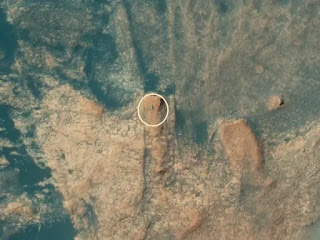How Some Clay Shows More Evidence of Past Life on Mars
For almost 9 years, the Curiosity rover has been exploring Mars and been looking for evidence of signs of life. Already, it has found evidence of water erosion, which includes ancient river delts, streams, or craters that could have served as lakes. While Curiosity’s official mission window has ended and more emphasis is being put on Perseverance, Curiosity is still roving around Mars. And it is still making important discoveries on Mars. Curiosity may have just found more evidence that proves that life once existed on Mars.
 |
| Curiosity in Gale Crater Captured by the Mar's Reconnaissance Orbiter |
Curiosity took two samples of the ancient mudstone, a sedimentary rock that contains clay. Instead of consisting completely of clay, researchers found that the samples contained only half the expected amount of clay minerals. Instead, there was a higher quantity of iron oxide in the sample, which is just rust. Scientists now believe that the reason this is happening is because of brine. Brine is super salty water that can leak into the mineral-rich-clay layers and destabilize them, which can wipe away geological and biological patches. Curiosity completed its full analysis using its CheMin tool, which is the chemistry and mineralogy instrument.
 |
| Diagenesis |
 |
| Curiosity Taking A Selfie in Gale Crater |
Major, Posted by Jason. “Is Mars Alive? Curiosity Uncovers Organics and Methane in Gale Crater.” Lights in the Dark, 17 Dec. 2014, lightsinthedark.com/2014/12/17/is-mars-alive-curiosity-uncovers-organics-and-methane-in-gale-crater/.
“Mars Science Laboratory Curiosity Rover - Mars Missions - NASA Jet Propulsion Laboratory.” NASA, NASA, www.jpl.nasa.gov/missions/mars-science-laboratory-curiosity-rover-msl.
- Montañez I.P., Crossey L.J. (2018) Diagenesis. In: White W.M. (eds) Encyclopedia of Geochemistry. Encyclopedia of Earth Sciences Series. Springer, Cham. https://doi.org/10.1007/978-3-319-39312-4_35
Turner, Ben. “Curiosity Rover Discovers That Evidence of Past Life on Mars May Have Been Erased.” Space.com, Space, 17 July 2021, www.space.com/mars-life-evidence-erased.


Comments
Post a Comment